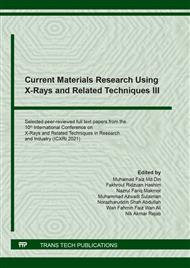p.208
p.223
p.228
p.234
p.240
p.245
p.253
p.259
p.265
Development and Characterisation of Triaxial Electrical Porcelains from Malaysian Ceramic Minerals
Abstract:
Four formulations of triaxial porcelain composed from 34 – 49% clay, 13 – 22% potash feldspar, 10 – 30% Soda feldspar and 14 – 28% silica sand, were prepared from raw materials sourced from Malaysian deposits. Specimens were made using the dry pressing method and characterized in terms of constituent oxide composition, compressive strength and powder-XRD analyses, respectively. XRD studies revealed that the crystalline phases are mullite and quartz and their intensity is almost identical for all samples fired at 1250°C but there is a decrease in quartz content as temperature is increased. Samples with 28% sand content resulted in higher compressive strength compared to those containing 14% and 25% sand. The major factor influencing compressive strength was found to be porosity in samples as opposed to crystallinity. A body EP3 with 64.9% SiO2, 25.4% Al2O3, 3.6% K2O, 1.5% Na2O and 1.09% others exhibited best mechanical properties due to greater density and lower porosity formation.
Info:
Periodical:
Pages:
240-244
Citation:
Online since:
January 2022
Keywords:
Price:
Сopyright:
© 2022 Trans Tech Publications Ltd. All Rights Reserved
Share:
Citation:


